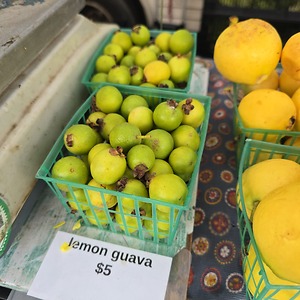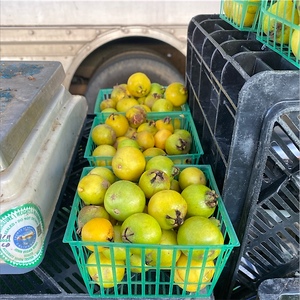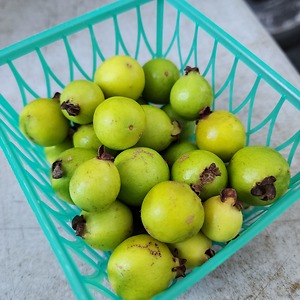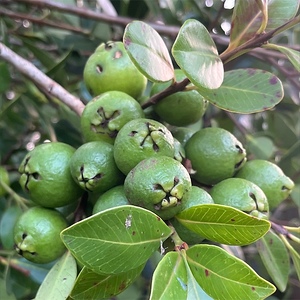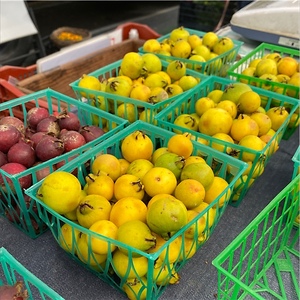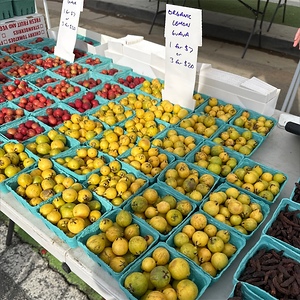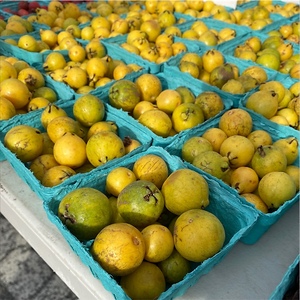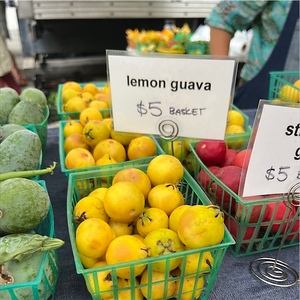

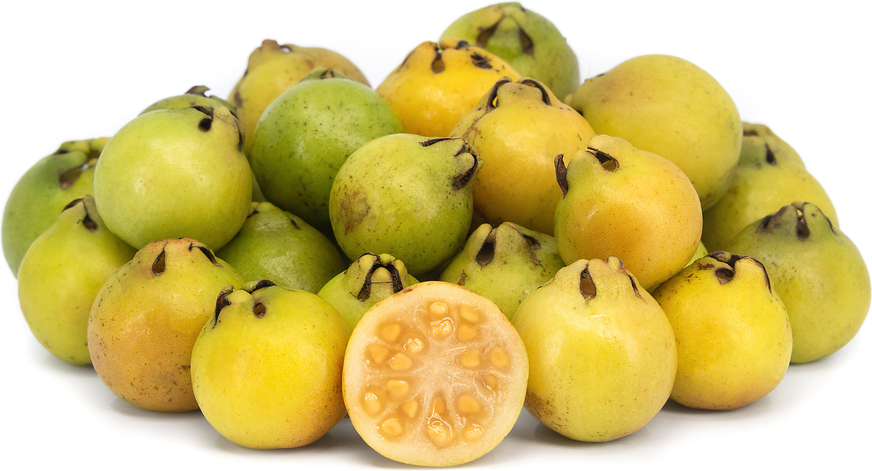
Lemon Guavas
Estimated Inventory, bskt : 0
Description/Taste
Lemon guavas are small in size, averaging 3 to 8 centimeters in diameter, and have a round, ovoid, to oval shape with a distinct, open calyx opposite the stem end. The fruit’s skin is thin, being easily punctured, scraped, or damaged, and has a smooth, taut, and matte appearance. The skin also ripens from green to a saturated golden yellow, developing a slight give when ripe. Underneath the surface, the pale yellow-orange flesh is soft, tender, aqueous, and jelly-like. The flesh is also somewhat translucent and is filled with tiny, hard, tan seeds. The seeds are edible, but due to their tough nature, they are generally swallowed whole or spit out, depending on preference. Lemon guavas release a refreshing, tropical aroma when ripe. Select fruits that have almost entirely turned yellow for the sweetest taste. Ripe fruits should also easily detach from the tree with a gentle tug if foraging. Lemon guavas are edible raw and have a sweet, subtly acidic, tangy, and bright taste with floral, tropical, and lemon-like nuances.
Seasons/Availability
Lemon guavas are available in the late summer through winter. In some tropical regions, fruiting may occur year-round.
Current Facts
Lemon guavas, botanically classified as Psidium cattleianum x lucidum, are a South American species belonging to the Myrtaceae family. The fruits grow on small evergreen trees or shrubs reaching 4 to 12 meters in height and are traditionally foraged for culinary use. Lemon guavas are known by several names worldwide, including Yellow Strawberry guava, Yellow Cattley guava, Yellow Cherry guava, Guyaba japonesa, and Waiawi. The species is grown on a small scale for commercial sale and is favored by farmers for its productive nature, disease resistance, drought tolerance, and fast-growing characteristics. One Lemon guava tree is said to produce over 136 kilograms of fruit in a single season. Most commercially grown Lemon guavas are sold for processing into beverages, jams, pastes, syrups, and preserves. The fruit has notoriously thin skin that is easily damaged, making it an unsuccessful fruit to market fresh. Lemon guavas are sometimes found directly through growers or farmer’s markets, but the fruits are more popularly harvested from wild or home garden trees. Lemon guavas have a sweet and subtly tangy taste and are widely used worldwide in sweet and savory culinary preparations, especially in the Americas.
Nutritional Value
Lemon guavas are a source of potassium to balance fluid levels, vitamin C to boost the immune system, and vitamin A to maintain healthy organ functioning. The fruits also provide fiber to regulate the digestive tract, magnesium to maintain healthy organ functions, calcium to build strong bones and teeth, and other nutrients, including iron, folate, phosphorus, and B vitamins.
Applications
Lemon guavas have a sweet, tropical, and tangy taste suited for fresh and cooked preparations. The species is typically consumed out of hand, and the skin, flesh, and seeds are edible. It is important to note that the seeds are often considered too firm to chew and are swallowed whole with the flesh or spit out and discarded. Lemon guavas can also be pressed through a strainer or sieve to separate the flesh and juice from the seeds. The fruits can be sliced and served on charcuterie plates with cheese, tossed into salads, mixed into fruit medleys, or used as a topping over parfaits. Lemon guavas are also blended and frozen into sorbet, ice cream, or popsicles and infused into marinades, chutney, relishes, and dressings as a sweet flavoring. In addition to fresh preparations, Lemon guavas are simmered into jams, jellies, and syrups or made into pastes and fillings for baked goods such as cakes, pies, and cookies. The fruits are also dried into fruit leather or incorporated into various beverages like wine, liqueur, smoothies, and fruit juices. Lemon guavas pair well with fruits such as strawberries, passion fruit, coconut, and pineapple, herbs including thyme, tarragon, and basil, and meats such as poultry, pork, or fish. The fruits have a short shelf life and last only 2 to 3 days. It is important to note that Lemon guavas will continue to ripen off the tree and should be stored at room temperature until ripe. Once mature, they should be kept in the refrigerator.
Ethnic/Cultural Info
Guavas are incorporated into a thick, sweet paste used in the signature dessert Bolo de Rolo, a specialty of the state of Pernambuco in northeastern Brazil. Bolo de Rolo is also known as a Roll Cake, and the popular dessert is derived from Portuguese recipes similar to a jelly roll cake. Historically, a Portuguese dessert, Colchão de Noiva, was introduced to Brazil in the 17th century with settling Portuguese colonists. The original recipe was comprised of thinly rolled sponge cake with an almond paste filling, but bakers discovered that some of the ingredients in the classic recipe were challenging to find in Brazil. The recipe was altered to utilize available ingredients, and guava became an essential element in the paste filling. The new cake variation was named Bolo de Rolo, “bolo” meaning “cake” and “rolo” meaning “rolling pin,” and some of the spiraled rolled cakes can feature up to twenty layers. Bolo de Rolo was initially reserved for the upper class and nobility, but it was eventually shared with the masses, which spread the dessert’s notoriety. In 2008, Bolo de Rolo was even officially recognized by the Pernambuco government as a cultural delicacy of the state. In modern preparations, Bolo de Rolo is time-consuming, and the cakes are typically made through coffee shops, bakeries, and various restaurants rather than at home. Lemon guavas are favored for their less astringent nature than strawberry guavas and are a valued variation to red or pink-fleshed varieties.
Geography/History
Lemon guavas are native to South America and have been growing wild since ancient times. The species’ center of origin is thought to be Southeastern Brazil in coastal lowlands, and over time, seeds from the fruit were spread throughout tropical and subtropical regions in South America through animals, human migration, and other natural causes. Lemon guavas were historically used as a food source in South America, and the species is hardy and able to naturalize in varying growing environments. Lemon guavas were also carried to Europe and studied by English horticulturist William Cattley in the early 1800s. This is where the species earned its Yellow Cattley guava moniker. In the 18th and 19th centuries, Lemon guavas were imported into Florida and Hawaii and were initially planted as an ornamental species. The plants quickly escaped cultivation and naturalized in these growing environments, eventually becoming an aggressive invasive species. They were also planted in Southern California and were later introduced to Australia and parts of Asia. Today, Lemon guavas have spread worldwide and thrive in tropical to subtropical climates in undisturbed areas. The species grows wild, is planted on a small scale for processing, and is sown in home gardens. When in season, Lemon guavas are offered directly through growers or occasionally found at farmer’s markets.



